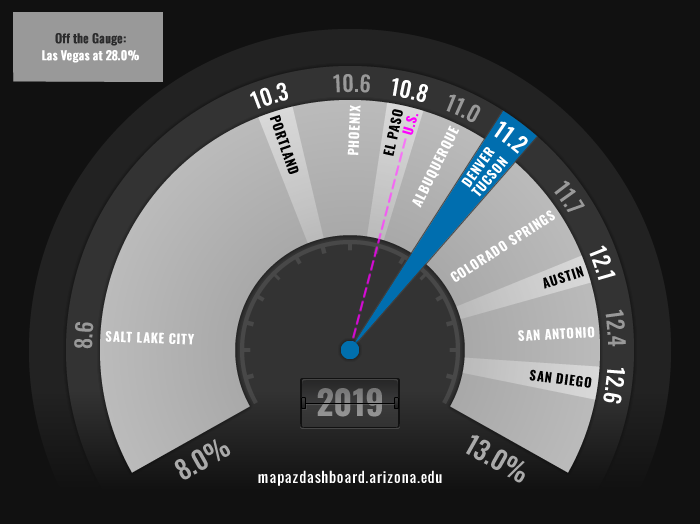The COVID-19 pandemic has world-wide consequences for not only the health and wellbeing of individuals but also the global economy. Recent research by the Brookings Institute provides a glimpse into which regions of the U.S. are likely to be hit the hardest by a COVID-19 recession. The report points out that not all regions of the U.S. will be hit equally. It will depend on the region’s mix of exposed industries. The pending recession will impact different areas in disparate, uneven ways. When comparing peer westerns metropolitan areas it appears that Tucson falls squarely in the middle in terms of exposed industries.
To examine the impact, Brookings mapped the employment of the industries most vulnerable to disruption by COVID-19 related demand declines, shutdowns, and layoffs. The report used the industry groups that Mark Zandi, chief economist at Moody’s, identified as the most at risk. They include mining/oil and gas, transportation, employment services, travel arrangements, and leisure & hospitality. In Tucson, the leisure & hospitality sector accounted for 44,617 jobs or 11.2% of total employment in 2019. That ranked Tucson in the middle of peer metropolitan areas as illustrated in Figure 1.
Figure 1: Employment Share of Leisure and Hospitality Industry (2019)

In the U.S. more than 24.2 million people work in the industries most vulnerable to a COVID-19 recession according to the report. That represented 16.5% of all jobs in 2019. In Tucson, there were 64,063 people employed by the high-risk industries in 2019, representing 17.2% of jobs. The leisure & hospitality sector mentioned above made up a large majority of those jobs. When compared to peer western metros Tucson ranked 5th, tied with San Diego, in the percent of jobs in high-risk industries (Figure 2). Las Vegas had the most exposure of peer western metros with 33.8% of their jobs in high-risk industries, while Albuquerque had the least at 14.9%.
Figure 2: Percent of Jobs in Industries at High-Risk from COVID-19
The Brookings report examined all the metros in the U.S. and found that Midland, Texas was the most exposed area with 42% of its workforce in high-risk industries. Other major oil-and-gas towns like Odessa and Laredo, Texas were also among the top 10 most affected. Those metros with a large leisure & hospitality sector were also projected to be highly impacted, like Kahului, Hawaii and Las Vegas, Nevada. Additionally, other notable tourist destinations found themselves high on the list of vulnerable areas. At the other end were metros that consisted of manufacturing-heavy industries and agricultural towns. To see the full list of metros visit the article “The places a COVID-19 recession will likely hit hardest” by Brookings.












